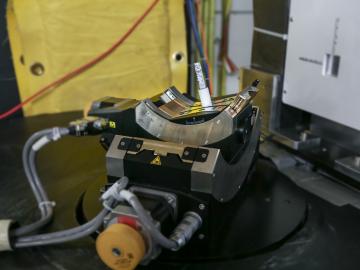
Filter News
Area of Research
- Advanced Manufacturing (2)
- Biology and Environment (18)
- Computational Engineering (1)
- Computer Science (10)
- Electricity and Smart Grid (1)
- Energy Science (34)
- Functional Materials for Energy (1)
- Fusion and Fission (1)
- Fusion Energy (2)
- Isotopes (1)
- Materials (34)
- Materials for Computing (5)
- National Security (22)
- Neutron Science (14)
- Nuclear Science and Technology (3)
- Quantum information Science (6)
- Supercomputing (79)
News Topics
- (-) Artificial Intelligence (35)
- (-) Computer Science (108)
- (-) Cybersecurity (19)
- (-) Frontier (13)
- (-) Microscopy (31)
- 3-D Printing/Advanced Manufacturing (60)
- Advanced Reactors (26)
- Big Data (28)
- Bioenergy (43)
- Biology (34)
- Biomedical (38)
- Biotechnology (6)
- Buildings (17)
- Chemical Sciences (20)
- Clean Water (13)
- Composites (9)
- Coronavirus (34)
- Critical Materials (7)
- Element Discovery (1)
- Energy Storage (56)
- Environment (87)
- Exascale Computing (13)
- Fossil Energy (1)
- Fusion (29)
- Grid (28)
- High-Performance Computing (19)
- Hydropower (8)
- Irradiation (1)
- Isotopes (19)
- ITER (2)
- Machine Learning (23)
- Materials (39)
- Materials Science (83)
- Mathematics (2)
- Mercury (4)
- Molten Salt (7)
- Nanotechnology (41)
- National Security (19)
- Neutron Science (78)
- Nuclear Energy (68)
- Partnerships (8)
- Physics (38)
- Polymers (19)
- Quantum Computing (7)
- Quantum Science (36)
- Security (16)
- Simulation (6)
- Space Exploration (12)
- Summit (35)
- Transportation (44)
Media Contacts

Oak Ridge National Laboratory researchers are developing a first-of-its-kind artificial intelligence device for neutron scattering called Hyperspectral Computed Tomography, or HyperCT.

Cameras see the world differently than humans. Resolution, equipment, lighting, distance and atmospheric conditions can impact how a person interprets objects on a photo.

When the COVID-19 pandemic stunned the world in 2020, researchers at ORNL wondered how they could extend their support and help

Chemical and environmental engineer Samarthya Bhagia is focused on achieving carbon neutrality and a circular economy by designing new plant-based materials for a range of applications from energy storage devices and sensors to environmentally friendly bioplastics.

Though Nell Barber wasn’t sure what her future held after graduating with a bachelor’s degree in psychology, she now uses her interest in human behavior to design systems that leverage machine learning algorithms to identify faces in a crowd.

Doug Kothe has been named associate laboratory director for the Computing and Computational Sciences Directorate at ORNL, effective June 6.

To optimize biomaterials for reliable, cost-effective paper production, building construction, and biofuel development, researchers often study the structure of plant cells using techniques such as freezing plant samples or placing them in a vacuum.

Oak Ridge National Laboratory researchers developed an invertible neural network, a type of artificial intelligence that mimics the human brain, to improve accuracy in climate-change models and predictions.

Scientists develop environmental justice lens to identify neighborhoods vulnerable to climate change
A new capability to identify urban neighborhoods, down to the block and building level, that are most vulnerable to climate change could help ensure that mitigation and resilience programs reach the people who need them the most.

The Frontier supercomputer at the Department of Energy’s Oak Ridge National Laboratory earned the top ranking today as the world’s fastest on the 59th TOP500 list, with 1.1 exaflops of performance. The system is the first to achieve an unprecedented level of computing performance known as exascale, a threshold of a quintillion calculations per second.


